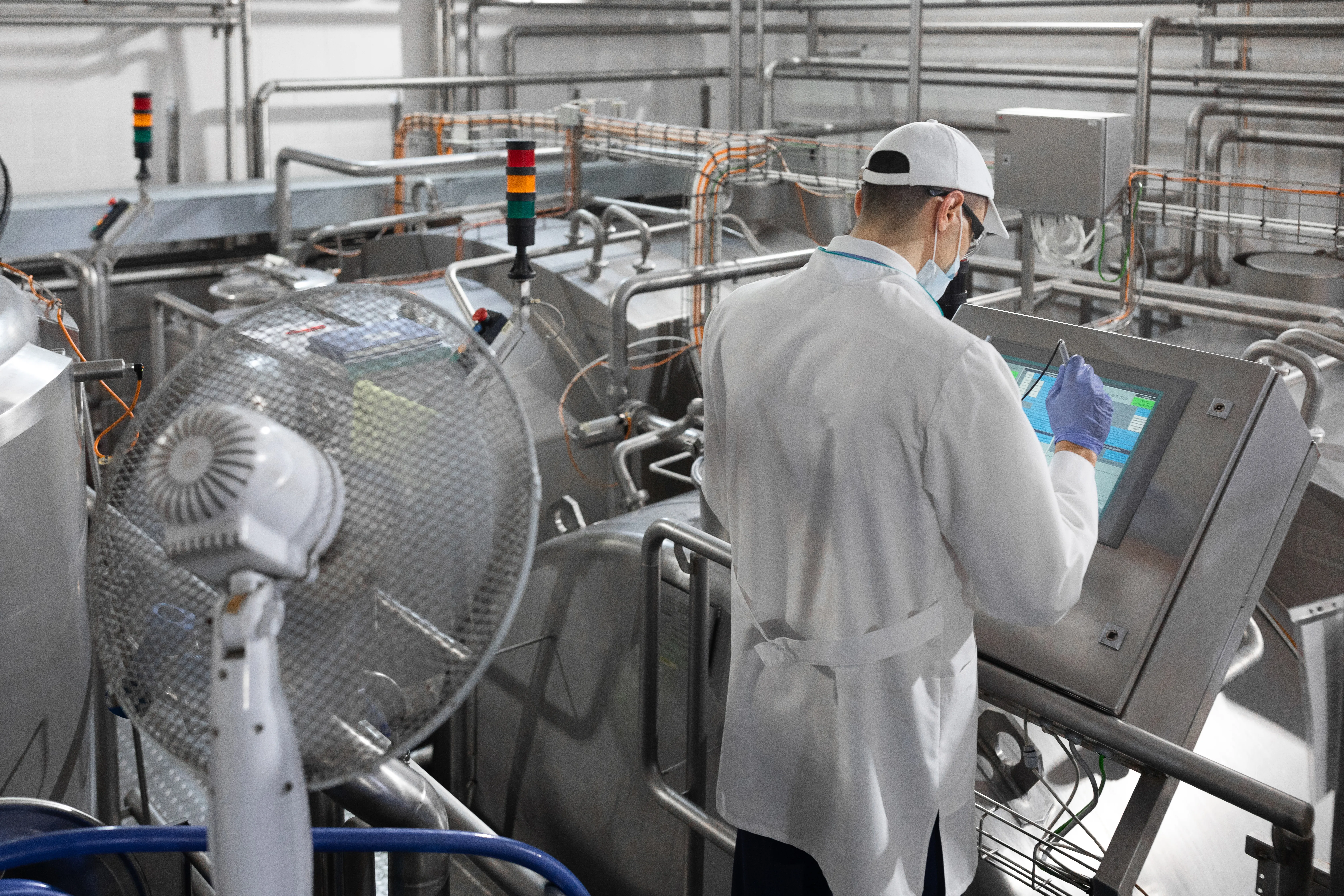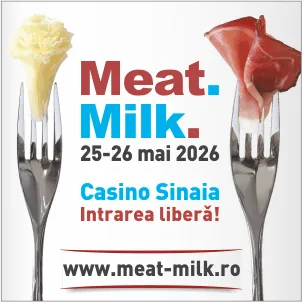1628

Romania’s Meat and Dairy Sectors – Outlook 2024-2028
Despite their enormous potential, Romania’s meat and dairy sectors are currently going through an extremely challenging period. It can be said that the market is experiencing a state of growing disarray, particularly in the meat sector.
This situation is clearly illustrated in the report "Romanian Market of Meat and Milk Products – Outlook 2024–2028," from which we present the most important data and insights, supplemented by forecasts from the USDA, following the elimination of tax incentives for farmers and the food industry. Both analyses cite data from the National Institute of Statistics (INS), the Ministry of Finance, and various media sources.
Meat Production in Romania
In 2024, Romania recorded a significant trade deficit in meat and meat products, importing much more than it exported.
Imports:
- In the first four months of 2024, Romania imported meat and meat preparations worth €599 million.
- In the first half of 2024, pork imports alone exceeded €500 million, while pork exports totaled just €1.2 million.
Exports:
- In the first four months of 2024, Romania exported meat and meat products worth €205.3 million.
- During the same period, live animal exports totaled €195.8 million.
These figures highlight a substantial trade deficit in meat and meat products, despite significant increases in domestic meat production across all animal species in 2024.
According to data published by the National Institute of Statistics (INS), the following changes were observed in October 2024 compared to October 2023:
- Cattle: 43,000 head slaughtered, carcass weight 6,958 tonnes.
- Pigs: 343,000 head slaughtered, carcass weight 30,639 tonnes.
- Sheep and goats: 322,000 head slaughtered, carcass weight 4,363 tonnes.
- Poultry: 29.976 million head slaughtered, carcass weight 49,975 tonnes.
These figures reflect a general upward trend in meat production in Romania throughout 2024, signaling the consolidation of the national livestock sector.
Steady Growth
Data show that Romania’s meat market has grown steadily in recent years, and this trend is expected to continue. Sales in 2024 and projections for 2028 indicate that meat sales are expected to rise from €3.5 billion in 2023 to approximately €3.9 billion in 2028, reflecting an annual growth rate of 1.5%.
Consumption is also projected to increase, albeit marginally, from 1.31 million metric tons in 2023 to 1.33 million metric tons in 2028, with an annual growth rate of just 0.2%.
Meat production is expected to remain relatively stable, with a slight increase from 1.069 million metric tons in 2023 to 1.070 million metric tons by 2028.
In 2023, Romania ranked 15th in meat sales in Europe, trailing Hungary (also at €3.5 billion), while the leading markets were France, Spain, and Italy.
Given the minimal growth rate, meat processing revenues in Romania are projected to reach €1.1 billion by 2026, up from €1.08 billion, growing at an annual rate of 1.3%.
In terms of product variety, the report states that sausage and similar meat product manufacturing will remain dominant, with growth expected both in value and volume between 2024 and 2028.
Investment in the meat processing sector is also expected to continue, supporting increases in both revenue and production.
Key Players
According to 2022 data, the leading meat industry players in Romania by revenue and financial performance were:
- Smithfield Romania – Part of the Chinese WH Group, Smithfield leads Romania’s meat production and processing sector, posting revenues of about 1.28 billion lei in 2022. Losses increased to 3.1 million lei, and the average number of employees fell to 2,507.
- Aaylex One – Owner of the CocoRico chicken brand, reported a significant revenue increase to 1.14 billion lei in 2022 but recorded losses of 108 million lei. Average staff: 1,972.
- Transavia – One of the largest chicken producers, with 2022 revenues of 991 million lei (up 25%). Net profit: 205 million lei; employees: 1,979.
- Unicarm – Owned by businessman Vasile Lucuț from Satu Mare, achieved 965 million lei in revenue (up 35%) and 19 million lei net profit, employing 2,656 people.
- Agricola International – Based in Bacău, posted a 48% revenue increase to 765 million lei and a net profit of 79 million lei with 1,914 employees.
- Elit SRL (now part of Comtim Holding) – Acquired by Smithfield in 2017, reported 742 million lei in revenue (up 16%) and a 74 million lei net profit in 2022.
- Cris-Tim Family Holding SRL – Reported 611 million lei in revenue (up 28%), with a 5 million lei net profit and 1,996 employees.
- Caroli Foods – Owned by Mexico’s Sigma Alimentos, with 545 million lei in revenue (up 14%) but losses of 3.3 million lei and 1,118 employees.
- Scandia Food – Recorded revenues of 533 million lei (up nearly 38%) and a net profit of 59 million lei, employing 718 people.
- Diana SRL – Based in Râmnicu Vâlcea, saw revenues rise 38% to 385 million lei, with a net profit of 17 million lei and 594 employees.
These companies dominate Romania’s meat market and play a significant role in national meat production and processing.
Dairy Production in Romania
Although Romania has traditionally been a major milk producer, the sector is currently undergoing significant transformations.
According to the Romanian Market of Meat and Milk Products – Outlook 2024–2028 report:
- Milk production: In 2023, Romania produced over 4.2 million tonnes of milk. By 2028, this figure is expected to decline to around 3.9 million tonnes, representing an average annual decrease of -1.5%.
- Milk consumption: In contrast, domestic consumption of milk and dairy products is expected to rise slightly, from 1.1 million tonnes in 2023 to 1.13 million tonnes in 2028, growing at an annual rate of 0.5%.
- Milk processing: Milk processing volumes will follow a slight downward trend, falling from 1.09 million tonnes in 2023 to 1.05 million tonnes in 2028.
This situation reflects both the demographic decline and the changes in dietary habits among Romanian consumers.
Decreasing Production, Increasing Imports
The dairy sector is facing major challenges, especially due to reduced raw milk production. One significant factor is the gradual disappearance of small and medium-sized farms, driven out by rising costs, insufficient support policies, and increased competition from imports.
Romania has become increasingly dependent on dairy imports. In 2023, the country imported about 160,000 tonnes of raw milk and dairy products, and by 2028, imports are expected to reach nearly 200,000 tonnes.
The main sources of dairy imports are European Union countries, especially Hungary, Poland, Germany, and the Netherlands.
Exports of Romanian dairy products remain modest, primarily targeting neighboring countries and the diaspora communities.
The Dairy Market in Figures
According to USDA data:
- In 2024, milk production in Romania is expected to reach 2.94 million tonnes, a slight decrease compared to previous years.
- Cheese production is estimated at 85,000 tonnes, while butter production will be around 9,000 tonnes.
- Romania will import approximately 240,000 tonnes of dairy products in 2024.
- Domestic dairy consumption is forecasted at about 2.7 million tonnes.
Challenges and Opportunities
The main challenges for the Romanian dairy industry include:
- Low farm profitability, especially for small producers.
- Labor shortages in rural areas.
- Strong competition from imports and multinational brands.
- Price volatility in the domestic market.
On the other hand, there are growth opportunities for companies that focus on:
- Premium, organic, and local products.
- Product innovation (functional dairy, lactose-free, etc.).
- Investments in technology and farm modernization.
The Romanian dairy market is increasingly segmented, with a growing number of consumers willing to pay more for quality, traceability, and sustainability.
Milk and Dairy Production
According to INS sources, the report mentions that in May 2024, the quantity of cow’s milk collected from farms and collection centers by processing units increased by 9.5% compared to the previous month.
In terms of consumption trends, an increase in the consumption of fresh milk was observed, while UHT milk recorded a slight decline. Whole milk experienced positive growth, indicating a growing preference for products with higher fat content.
As a result of the cap imposed on commercial markups, in August 2024, the price of yogurt fell by 10.5% compared to June. However, yogurt consumption fluctuated under the impact of inflation, with a slight decrease in sales volumes.
Conversely, there was a rise in interest in locally produced cheeses, with consumers showing a preference for traditional and artisanal products. Consequently, in August 2024, the price of "telemea" cheese dropped by 16.38% compared to June, positively influencing sales volumes.
Regarding the consumption of butter and cream, 2024 showed stability. These categories maintained relatively constant consumption levels, with no significant variations in sales volumes.
Romania's International Trade in Milk and Dairy Products
Imports
Despite positive domestic trends, Romania recorded a significant increase in raw milk imports in 2024 compared to the previous year. In the first ten months of 2024, processing units imported 129,258 tons of milk, marking an increase of nearly 30% compared to the same period in 2023, when imports totaled 89,463 tons.
This upward trend in raw milk imports was also evident in previous months of 2024. For example, in February 2024, the quantity of imported raw milk increased by 40.5% compared to February 2023.
The increase in imports can be attributed to several factors, including fluctuations in domestic production, market demands, and the commercial strategies of processing units.
In 2024, the sharp rise in raw milk imports had a direct impact on the production of dairy products. For instance, in September 2024, cheese production amounted to 8,443 tons, down by 11.3% compared to August 2024, while butter production rose by 9.9% during the same period, reaching 847 tons.
These figures suggest an increased dependency of Romania's dairy industry on raw milk imports to meet domestic market demands and support dairy product manufacturing.
Exports
In 2024, Romania also recorded a significant increase in the export of milk and dairy products. In the first two months of the year, exports totaled €55 million, marking a rise of over 300% compared to the same period in the previous year.
This expansion in exports can be attributed to several factors, including improved product quality, diversification of export markets, and increased international demand for Romanian dairy products.
It is important to note that alongside the increase in exports, Romania also registered a rise in raw milk imports, suggesting a complex dynamic within the internal and external dairy markets.
The upward trend in exports highlights the potential of Romania’s dairy sector and its ability to respond to international market demands.
General Trends for Meat and Dairy Products
As a general note, inflation has influenced consumer behavior, causing fluctuations in sales volumes and a shift toward products offering better value for money.
Government regulations and interventions, such as the capping of commercial markups, have had a direct impact on prices and, consequently, on consumption patterns.
In conclusion, 2024 brought significant changes to Romania's dairy market, with notable variations in consumption and prices across different product categories, driven by economic factors and regulatory measures.
Unfortunately, the cancellation of tax facilities for companies in the meat and dairy processing sectors, scheduled for 2025, will have significant implications for the agri-food industry.
Anticipated Impacts:
- Increase in Labor Costs: The elimination of tax exemptions for employees will raise labor expenses, impacting company profitability.
- Reduced Competitiveness: Higher operational costs may diminish Romanian firms’ ability to compete in both domestic and international markets, favoring imports.
- Risk of Bankruptcies and Job Losses: Increased expenses without adequate compensation could lead to business closures and layoffs across the production and processing chain.
- Decline in Sector Investments: Fiscal uncertainty and reduced profit margins could discourage investments in new technologies and production capacity expansion.
- Impact on Food Security: Decreased domestic production could increase reliance on imports, making the national food market more vulnerable.
Representatives of the agricultural and food sectors have voiced concern over these measures, emphasizing the associated risks and calling for a reconsideration of decisions to protect the national industry.





